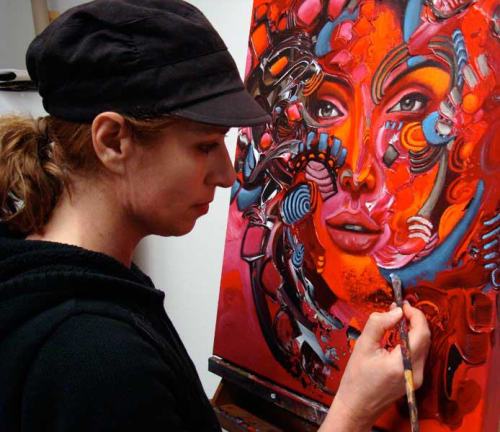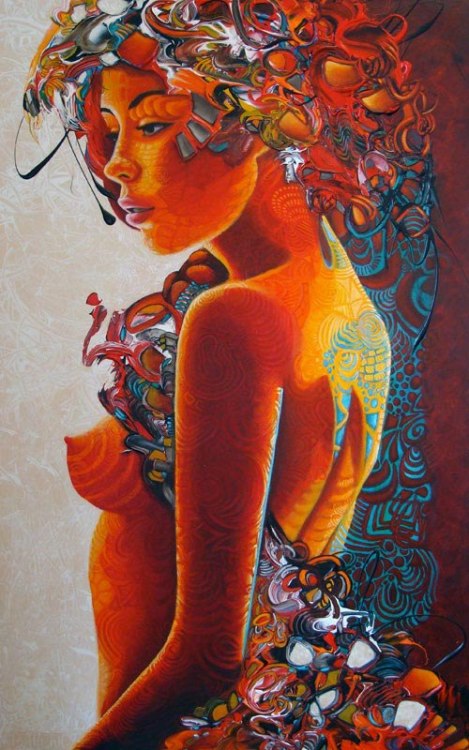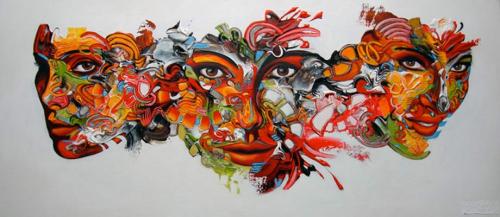Vernon Ah Kee is clearly one of Australia’s most political Aboriginal artists of the 21st century, who makes up part of the Proppa-now initiative which formed in early 2000 fighting against oppression and racism with outspoken confronting artworks. Ah Kee was born in the North of Queensland and is of the Gugu Yimithirr, Kuku Yalandji, Waanji, and Yidindji tribes, but has now lived in Brisbane for the last 12 years. Ah Kee has forged a name for himself with his large charcoal portraits that pay homage to the past, along with bold text-based artworks advertising mottos, which aim to challenge the definitions of what constitutes as Aboriginal identity. The premise for these works began during Ah Kee’s time as a student when he was studying at the Queensland College of Art until in 1991 when he dropped out after the death of his maternal grandfather with whom he was very close. During the time when Ah Kee was not in University he was employed as a screen printer for various T-shirt companies where he worked several stints before he returned to complete art school. Eventually when Ah Kee was in his late twenties he returned to art school at Griffith University in Brisbane where he completed a Bachelor of Visual Arts, majoring in drawing and screen-printing, along with an honours degree. Additionally, Ah Kee went on to complete his Doctorate of Visual Arts at the Queensland College of Art whilst sidelining as an Associate Lecturer for five years.
During Ah Kee’s time at the University of Queensland was when his interest in typography was first piqued with text-driven works by artists such as; the revolutionary feminist Guerilla Girls and American artist Barbara Krueger. It was in the course of Ah Kee’s third year at art school that he held his debut show titled “If I Was White” at Metro Arts, which was reviewed by fellow art student John Milani who chose to review it the exhibition as a component of his assessment . Consequently when Milani went to work at the exceptionally influential commercial gallery in Brisbane managed by Peter Bellas, he signed Ah Kee after discussing it with Bellas. Together they decided to represent Ah Kee with his exhibition “If I Was White, in 2002 which sold to the National Gallery Of Australia and the National Gallery Of Victoria. Bellas has since retired, handing the gallery over to Milani who has continued to be Ah Kee's dealer and with whom he has developed a close friendship. Milani now also represents Ah Kee’s Proppa Now associate, the colourful and forthright Richard Bell.
Ah Kee’s work is predominantly a critical evaluation of popular culture here in Australia. More specifically it is a platform for the black/white discourse which is explored with biting and pithy dialogue delivered through bold black text that runs together on a white canvas outlining the dichotomy between black and white Australian cultures. Throughout the years Ah Kee has refined text as the primary visual component with provocative themes that are hard hitting, sometimes terse, yet profoundly beautiful and poetic, at times even humorous. However, it is easy to understand how at times the provocative themes he undertakes could fail to reach their target audience and may cause reactions of anger rather than responses of unity and understanding. Ah Kee will render no apology for his condemnation of an industry he holds responsible for fabricating, then perpetuating, a misleading and marginally defined identity for Aboriginal people or for offending many Aboriginal art curators in the process. Ah Kee is quoted as saying;
My work is not always about sending out a message, but if it needs to be made, then you have to make sure that message is clear…The problem with art produced and retailed through art centres, if you want to call it art, is that the artists don't understand their role. I'm talking about the narrow definition of Aboriginal art that the people in remote communities live up to, to their own detriment…It's important for Aboriginal artists to understand that art in Western culture is a commodity, and the art market an industry that runs like a well-oiled machine. The artist's role is to work within that system to create exceptional art.
Ah Kee’s concern is that many Aboriginal communities are in upheaval, rife with illness and poverty stricken. Yet, when we assess the art that continues to emerge from those indigenous regions to be exhibited in the galleries of Sydney and Melbourne we are led to believe the artist’s lives are ideal. One of Ah Kee’s main concerns is that there seems to be no real accurate criticism when it comes to Aboriginal art and the mythology he considers surrounds it. He believes that there are far too many people who seem to want to succumb to ‘that romantic ideal, that identity, that aesthetic’. In Ah Kee’s opinion, Aboriginal art ought to be as diverse as the Indigenous people within our communities. Ah Kee states,
My work is about my life now," he says. "I use my own family to demonstrate the depth and complexity of modern Aboriginal life. I'm expanding the idea of what it means to be Aboriginal and what it means to be human. A lot of the problem this country has with Aboriginal people is that it struggles to see Aboriginal people as fully human.
Yet, Ah Kee believes his Aboriginal heritage, is not an issue and bears no weight or significance for a critical appreciation of his work. Although he has expressed a curiosity as to his Chinese heritage, which is the origin of his surname and the legacy of his paternal great-grandfather. Ah Kee has questioned if there is indeed anything in his make-up that might give an indication to that side of his family’s history of which he knows very little.
Although Ah Kee initially had no intention to dedicate his days to art, he has always had a natural talent and been fixated on the process of drawing, which was influenced and developed due to his love of comic books. Aside from his text inspired works, Ah Kee is renown for his abundent charcoal and pastel drawings on canvas of family members which were created to provide some insight into the past of his ancestors and of Indigenous life in Queensland. To a large extent the original source material from which Ah Kee’s portraits were inspired, evolved from a whole series of drawings that are in essence archival images of his great-grandparents and his grandfather from Palm Island who were shot in 1938. Ah Kee describes how the photographs were essentially a collection of scientific records from anthropologist Norman Tinsdale who went around Australia to Aboriginal communities throughout the 1920s to the 1960s, documenting and giving classifications to a dying species. Although well intentioned, Tinsdale identified this exotic 'other' by labelling them with serial numbers, rather than by name, which only served to further alienate those who already been pushed to the side and forced to live in Aboriginal reserves and missions in a kind desperate sub-human existence. Upon looking at Ah Kee’s drawings it would seem that his images are a direct response to the past of romanticized and exotic portraits of ‘primitives’ that are secured in scientific records and museums, which have been translated to a modern people occupying current spaces and real time.
Ah Kee’s drawings undoubtedly inhabit the space with an undeniable human presence and more so, as a stand from those of indigenous backgrounds. The focus of each subject in these oversized portraits is their ‘gaze’ which leaves the viewer with a real sense of discomfort, as though they are being confronted by the act of the stare and having to look into the face of an accuser. Although for Ah Kee there is comfort in the eyes of his family staring back at him and being surrounded by the familiar. Ah Kee is quoted as saying,
"But what was particular about the images to me was the gaze, this very intense gaze, and profoundly affected me. So what I'm doing is I'm representing those images and trying to retain the gaze, cos it was a gaze of endurance and persistence and intelligence and emotion and depth. And a kind of deep-thinking and hunger that is not normally associated with black people. I'm trying to establish an idea of Aboriginal that is contemporary and modern and stripped of all the romantic ideas around spirituality and virtue and the decorative Stone Age. So, I'm trying to demonstrate that Aboriginal art is more than what we think it is and that Aboriginal people, as a subject, is more than what we think it is. And, even more than that, it's a beautiful thing."
Apparently it is not unusual for the artist to turn out the lights in his studio at times and just sit in silence among the various portraits he is working on and with which he finds solace. Currently Ah Kee has created well over 40 family portraits and anticipates he will complete up to 100. Ah Kee was especially pleased with those of his portraits which were exhibited at the Sydney Biennale in 2009 because of the way in which the so compellingly confronted the viewer with the subjects' gaze. Ah kee was also one of a select group of Australians chosen to display his works at the Venice Biennale being the most significant visual arts stage in the world. Additionally he had 12 of his artworks on display at Sydney's Cockatoo Island as a component of the biennale, along with three of his large charcoal portraits which hang in the Queensland Gallery of Modern Art. Due to the high standard of Ah Kee's portraites and obvious drawing skills, not to mention his international acclaim, Ah Kee receives many requests to create commissioned portraits of which he is not expecially interested. Even when the National Portrait Gallery enquired as to whether he would be prepared to create a portrait of Aboriginal leader Noel Pearson, he declined due to the fact that he does not respect the politics of Pearson enough.
In addition to being a portraitist and graphic artist Ah Kee has now added another medium to his practice being the video for the Cant Chant exhibition where Ah Kee seizes the iconic subject matter of the beach and assesses it with a critical point of view on its formative role in developing the Australian identity. This series of work casts aside the typical recognised ideal of the beach as being a environment associated with fun, relaxation and leisure and instead introduce it as a cultural battleground. The Cant Chant video features a young Aboriginal man who emerges as a new-age warrior, surfing the waves of North Queensland on a board painted with the bright markings from the rainforests shield designs of that region. For all intensive purposes the board almost appears to be transformed into a weapon, whilst other water – logged surfboards are featured floating dead upon the water after having been blasted by guns.
















